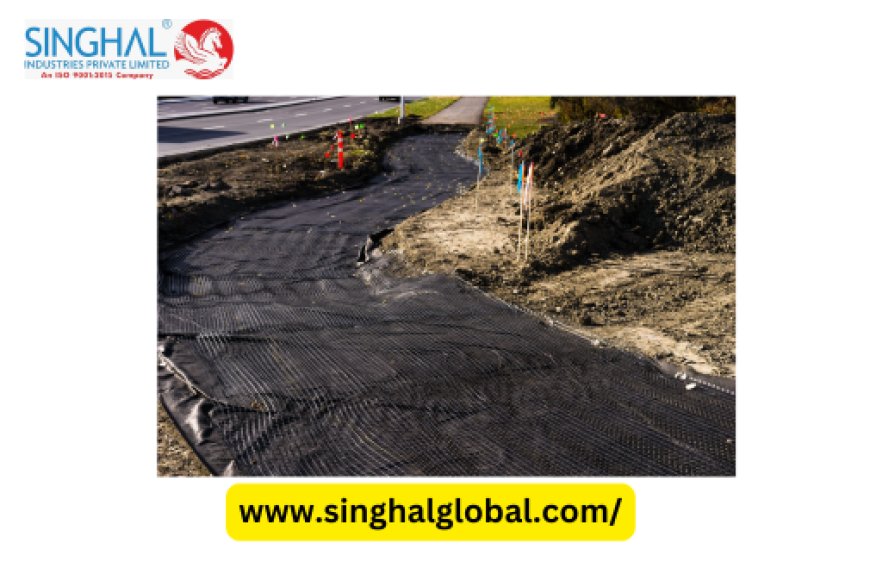Geonet: A Revolutionary Solution for Road Stabilization and Drainage

In modern infrastructure, road construction faces significant challenges due to varying soil conditions, water drainage issues, and environmental impacts. Among the numerous materials and technologies available, geonet stands out as an effective and sustainable solution for road stabilization and drainage. As engineers and contractors seek innovative ways to build durable roads with minimal environmental footprint, the use of geonet in road construction has become increasingly popular. This article delves into how geonet enhances road stability, its role in improving drainage systems, and the best practices for Geonet installation in roadways.
What is Geonet?
Geonet is a geosynthetic material made from high-density polyethylene (HDPE) or other polymers. It consists of a grid-like structure that provides excellent drainage and helps reinforce the soil by distributing loads more effectively. Primarily used in civil engineering projects, geonet has applications in road stabilization, drainage systems, retaining walls, landfills, and slope protection.
The material’s open, three-dimensional structure allows for easy water flow, making it a crucial component in managing water runoff and preventing erosion. At the same time, it strengthens the road base, reducing the likelihood of road deformation or failure under heavy traffic loads.
Why Geonet is Essential for Road Stabilization
In road construction, the stability of the subgrade—the foundation layer beneath the road surface—is crucial for ensuring the longevity and performance of the road. Weak or unstable subgrades can lead to cracking, rutting, and potholes, requiring frequent repairs and increasing long-term maintenance costs.
Geonet for road stabilization provides a highly effective solution by enhancing the load-bearing capacity of the subgrade. Here’s how geonet contributes to road stabilization:
-
Load Distribution: By creating a grid structure, geonet evenly distributes the weight of vehicles and construction loads, preventing excessive pressure on any single point. This minimizes the risk of road surface deformation, especially in areas with weak or compressible soils.
-
Soil Reinforcement: In soft soil areas, geonet acts as a reinforcement layer, preventing soil from shifting or settling unevenly. This stabilizes the roadbed, allowing for smoother and more durable road surfaces.
-
Erosion Control: Erosion due to water flow and soil movement can weaken the foundation of roads. Geonet helps by controlling erosion, retaining the soil structure, and providing a stable base for the road surface.
-
Reduced Material Requirements: The use of geonet can reduce the need for thick aggregate layers, lowering construction costs and material requirements. This makes road projects more sustainable and cost-effective.
Geonet Drainage in Road Construction
Proper drainage is a critical aspect of road construction. Water infiltration can weaken the subgrade, leading to road degradation over time. In poorly drained areas, roads are more prone to cracking, settling, and other structural issues. Geonet drainage in road construction helps manage water flow, protecting the road structure from water damage.
Here’s how geonet contributes to an efficient drainage system:
-
Water Flow Management: The open structure of geonet allows for lateral water flow, effectively channeling water away from the road surface and subgrade. This prevents water from accumulating and reduces the risk of saturation, which can lead to road failure.
-
Preventing Waterlogging: In areas with high water tables or heavy rainfall, water can accumulate beneath the road, causing instability and erosion. Geonet provides a drainage pathway, allowing water to flow out and preventing waterlogging.
-
Improved Pavement Lifespan: By efficiently managing water runoff, geonet extends the lifespan of pavements, reducing maintenance costs. Roads built with proper drainage systems tend to last longer and require fewer repairs.
-
Enhanced Environmental Protection: Using geonet drainage systems minimizes the impact on surrounding ecosystems by preventing uncontrolled water runoff and soil erosion. This helps preserve natural habitats near road construction sites.
Geonet Installation in Roadways: Best Practices
The installation of geonet in roadways is a crucial step that requires careful planning and execution. Proper installation ensures that the geonet performs optimally, contributing to both road stabilization and drainage. Here are some best practices for geonet installation in roadways:
-
Site Assessment: Before installation, it’s essential to conduct a thorough site assessment to identify the soil conditions, drainage requirements, and environmental factors. This helps in selecting the right type of geonet and determining the installation technique.
-
Subgrade Preparation: The subgrade should be properly graded and compacted before laying the geonet. A well-prepared subgrade ensures that the geonet remains in place and performs its functions effectively.
-
Geonet Placement: The geonet should be unrolled and placed evenly over the prepared subgrade. Ensure that the geonet covers the entire area that requires stabilization or drainage. In some cases, multiple layers of geonet may be needed for enhanced performance.
-
Anchoring and Overlaps: Secure the geonet with anchors or pins to prevent it from shifting during installation. Overlaps between geonet sections should be done correctly to ensure continuous coverage. Overlapping is especially important in areas with high water flow or heavy loads.
-
Filling and Compaction: After the geonet is in place, the fill material—such as gravel or aggregate—should be added and compacted to the desired thickness. The geonet acts as a reinforcement layer, stabilizing the fill material and enhancing the road’s durability.
-
Regular Maintenance: Even after installation, it’s essential to monitor the performance of the geonet and perform regular maintenance on the road to ensure its long-term functionality.
Advantages of Using Geonet for Road Construction
-
Cost-Effective: The use of geonet can significantly reduce the amount of material required for road construction, making it a more economical option. It also reduces long-term maintenance costs by extending the lifespan of the road.
-
Sustainability: Geonet systems promote the use of local and recycled materials for road fill, reducing the environmental impact of construction projects. Additionally, geonet minimizes the risk of soil erosion, protecting the surrounding landscape.
-
Versatility: Whether constructing roads in hilly regions, flood-prone areas, or deserts, geonet can be adapted to various environments. Its ability to reinforce weak soils and manage drainage makes it suitable for a wide range of applications.
-
Enhanced Road Performance: Roads built with geonet have higher load-bearing capacity, improved durability, and better drainage. This results in smoother road surfaces, fewer repairs, and greater safety for road users.
Conclusion
Geonet for road stabilization is a game-changer in the construction industry, offering both stability and efficient drainage solutions for roads in various terrains. By incorporating geonet drainage in road construction, engineers can effectively manage water runoff, prevent erosion, and extend the lifespan of roadways. Proper geonet installation in roadways ensures that the material functions optimally, contributing to safer, more durable, and environmentally friendly roads. As infrastructure projects in India and around the world continue to grow, geonet technology will remain a vital tool for achieving sustainable and cost-effective road construction.
Here Are Three Related for Geonet for road stabilization
Q1: How does geonet help in road stabilization?
Ans: Geonet reinforces the subgrade, evenly distributing loads and preventing soil displacement, resulting in more durable roads.
Q2: Why is drainage important in road construction?
Ans: Proper drainage prevents water accumulation, protecting the road from water damage and extending its lifespan.
Q3: What are the benefits of using geonet in road construction?
Ans: Geonet enhances road stability, improves drainage, reduces material costs, and supports sustainable construction practices.
What's Your Reaction?
























![Try Updated Microsoft AI-900 Exam Dumps: Ideal For Best Preparation [2024]](https://news.bangboxonline.com/uploads/images/202410/image_430x256_6704cd3d838a4.jpg)